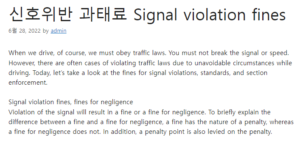When we drive, of course, we must obey traffic laws. You must not break the signal or speed. However, there are often cases of violating traffic laws due to unavoidable circumstances while driving. Today, let’s take a look at the fines for signal violations, standards, and section enforcement.
Signal violation fines, fines for negligence
Violation of the signal will result in a fine or a fine for negligence. To briefly explain the difference between a fine and a fine for negligence, a fine has the nature of a penalty, whereas a fine for negligence does not. In addition, a penalty point is also levied on the penalty.
Depending on how we crack down on it, we may pay a fine or a fine for negligence. If the unmanned enforcement camera is intercepted, the owner of the vehicle will be fined because it is not clear who the driver is. However, if the police directly crack down on the law, it is clear that the driver is violating the law, so a fine will be imposed immediately. The difference here is that fines are imposed on the owner of the vehicle and fines are imposed on the driver. 신호위반 과태료
Now, let’s get to the point and show the fines and fines for violating the signal in a table. Penalties are imposed without additional penalty points. For passenger cars, 70,000 won for general roads and 130,000 won for child protection areas are charged, and a van is 10,000 won more expensive. 좋은뉴스
On the other hand, the penalty is 15 points, and a fine of 60,000 won for passenger cars and 70,000 won, which is 10,000 won more expensive for a van, is imposed.

Signal violation standards
First of all, in case of direct police crackdown, of course, it will be based on entering the intersection at a red light. As people directly control, the standards can be subjective. That said, depending on the circumstances, it can be controversial.
However, what we are curious about is the standard for signal violations that are cracked down by surveillance cameras. First of all, if you enter an intersection at a red signal and pass through, it is a signal violation. To briefly explain how this enforcement works, there are two sensors located on the road. This sensor is a detection sensor that recognizes the weight of a vehicle as it passes by. If both the front and rear sensors pass after changing to a red signal, it is a signal violation. However, if you step on only one sensor in front of you, there will be no enforcement, so please rest assured.
Section enforcement principle
The principle of section enforcement is also simpler than you think. Install cameras at the 1st and 2nd enforcement points. And you know the distance from the primary camera to the secondary camera, and you know how long the car will take through that section. This allows the velocity to be calculated using the distance-in-hours formula. Therefore, it is said that the crackdown is based on how much time passes through the set section. Of course, it controls the average speed, but it also controls the speed of passing points in the 1st and 2nd sections, so keep that in mind.
Source: Kumho Tire
The fine for section enforcement is the same as for general speed camera enforcement. Please refer to the table below, such as a fine of 30,000 won for 20 km/h or less, and a fine of 60,000 won for 20-40 cases.